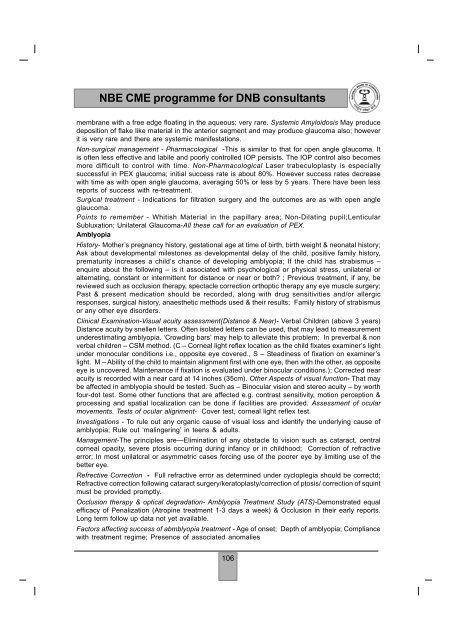NBE CME programme for DNB consultants - National Board Of ...
NBE CME programme for DNB consultants - National Board Of ...
NBE CME programme for DNB consultants - National Board Of ...
Create successful ePaper yourself
Turn your PDF publications into a flip-book with our unique Google optimized e-Paper software.
<strong>NBE</strong> <strong>CME</strong> <strong>programme</strong> <strong>for</strong> <strong>DNB</strong> <strong>consultants</strong>membrane with a free edge floating in the aqueous; very rare. Systemic Amyloidosis May producedeposition of flake like material in the anterior segment and may produce glaucoma also; howeverit is very rare and there are systemic manifestations.Non-surgical management - Pharmacological -This is similar to that <strong>for</strong> open angle glaucoma. Itis often less effective and labile and poorly controlled IOP persists. The IOP control also becomesmore difficult to control with time. Non-Pharmacological Laser trabeculoplasty is especiallysuccessful in PEX glaucoma; initial success rate is about 80%. However success rates decreasewith time as with open angle glaucoma, averaging 50% or less by 5 years. There have been lessreports of success with re-treatment.Surgical treatment - Indications <strong>for</strong> filtration surgery and the outcomes are as with open angleglaucoma.Points to remember - Whitish Material in the papillary area; Non-Dilating pupil;LenticularSubluxation; Unilateral Glaucoma-All these call <strong>for</strong> an evaluation of PEX.AmblyopiaHistory- Mother’s pregnancy history, gestational age at time of birth, birth weight & neonatal history;Ask about developmental milestones as developmental delay of the child, positive family history,prematurity increases a child’s chance of developing amblyopia; If the child has strabismus –enquire about the following – is it associated with psychological or physical stress, unilateral oralternating, constant or intermittent <strong>for</strong> distance or near or both? ; Previous treatment, if any, bereviewed such as occlusion therapy, spectacle correction orthoptic therapy any eye muscle surgery;Past & present medication should be recorded, along with drug sensitivities and/or allergicresponses, surgical history, anaesthetic methods used & their results; Family history of strabismusor any other eye disorders.Clinical Examination-Visual acuity assessment(Distance & Near)- Verbal Children (above 3 years)Distance acuity by snellen letters. <strong>Of</strong>ten isolated letters can be used, that may lead to measurementunderestimating amblyopia. ‘Crowding bars’ may help to alleviate this problem; In preverbal & nonverbal children – CSM method. (C – Corneal light reflex location as the child fixates examiner’s lightunder monocular conditions i.e., opposite eye covered., S – Steadiness of fixation on examiner’slight. M – Ability of the child to maintain alignment first with one eye, then with the other, as oppositeeye is uncovered. Maintenance if fixation is evaluated under binocular conditions.); Corrected nearacuity is recorded with a near card at 14 inches (35cm). Other Aspects of visual function- That maybe affected in amblyopia should be tested. Such as – Binocular vision and stereo acuity – by worthfour-dot test. Some other functions that are affected e.g. contrast sensitivity, motion perception &processing and spatial localization can be done if facilities are provided. Assessment of ocularmovements. Tests of ocular alignment- Cover test, corneal light reflex test.Investigations - To rule out any organic cause of visual loss and identify the underlying cause ofamblyopia; Rule out ‘malingering’ in teens & adults.Management-The principles are—Elimination of any obstacle to vision such as cataract, centralcorneal opacity, severe ptosis occurring during infancy or in childhood; Correction of refractiveerror; In most unilatcral or asymmetric cases <strong>for</strong>cing use of the poorer eye by limiting use of thebetter eye.Refrective Correction - Full refractive error as determined under cycloplegia should be correctd;Refractive correction following cataract surgery/keratoplasty/correction of ptosis/ correction of squintmust be provided promptly.Occlusion therapy & optical degradation- Amblyopia Treatment Study (ATS)-Demonstrated equalefficacy of Penalization (Atropine treatment 1-3 days a week) & Occlusion in their early reports.Long term follow up data not yet available.Factors affecting success of abmblyopia treatment - Age of onset; Depth of amblyopia; Compliancewith treatment regime; Presence of associated anomalies106
















